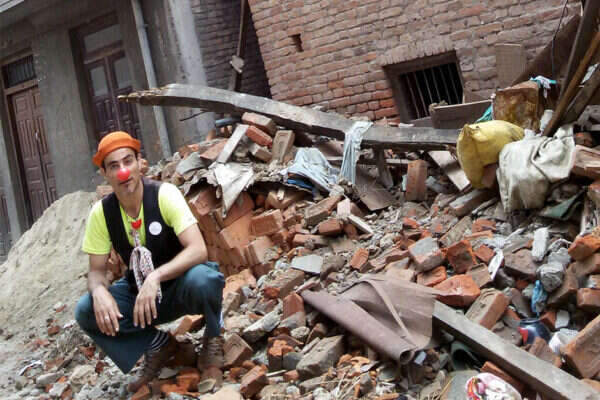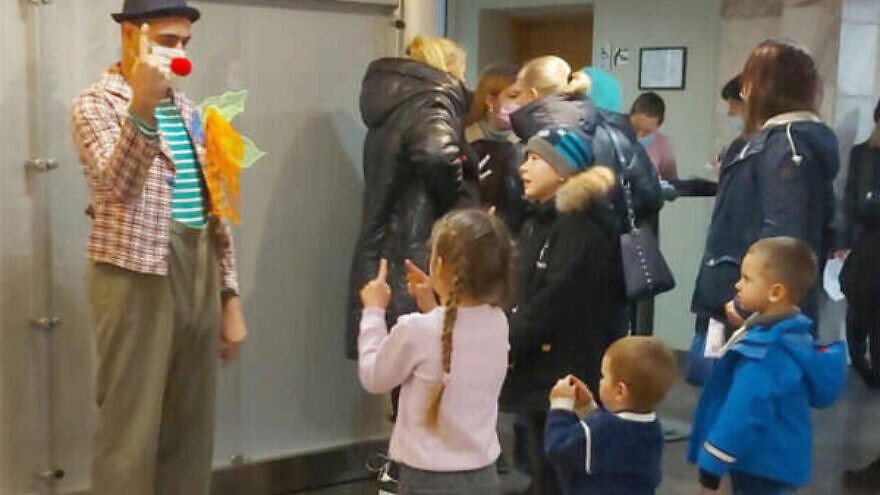Two weeks ago, Nimrod Eisenberg—a military medical clown—was ordered to get ready for a possible trip to war-torn Ukraine, “a kind of call up of reserve forces.” Only in his case, instead of packing an ironed uniform and a beret, he filled his duffel bag with a felt duck, colorful juggling balls, a clown hat, balloons, and last but not least, a red foam nose.
Eisenberg is the commander of the Israel Defense Forces’ medical clown unit. It includes five members—all reservists like Eisenberg—who are sent along with a healthcare team every time the IDF sets up a field hospital in areas of conflict. Eisenberg and his “fighters” use humor to communicate with the locals, especially children, and identify medical problems and injuries in a way that does not cause anxiety.
Last week it was announced the IDF would not be setting up field hospitals in Ukraine, but Eisenberg did not give up, and flew to Latvia on his own initiative to join local medical clowns as part of the Dream Doctors Project, an Israeli non-profit that integrates professional medical clowns into Israeli hospitals by training them to work as members of multidisciplinary care teams.
“The IDF hasn’t been called on yet, probably due to political sensitivity,” said Eisenberg. “If, in the end, the military does decide to set up a field hospital in eastern Europe, to aid refugees and the wounded in the Ukraine war, the medical clown unit will be there.”
Q: Does it not scare you to travel to such a dangerous area?
A: There is a general fear and worry because it is an unfamiliar place and situation, and due to the challenge. As a principle, like any soldier who sets out on a mission, every possible deployment of a field hospital is a peak moment we prepare for. It attracts me like a magnet. It’s a bit like a kamikaze. You jump into the fire and only then try to understand what’s happening there. There is something very Israeli about it, knowing how to improvise and be quick-witted. But besides that, a clown also needs to know how to bring joy, absurdity and humor to this chaos. It takes people out of the inferno they are in.

Q: What has your experience been like?
A: The atmosphere here is disorderly and wild. But the children are very funny and full of life, and clowns connect immediately. They don’t need an explanation. So I’ve found myself enjoying three things very much: First, taking a walk with the children here, and making up a funny story in the process. We made a train, played with soap bubbles, balloons and handkerchiefs. The place has become a kind of circus.
Second, which I adopted from street theater, is to be a clown in any situation. So I sat in a long line of refugees, filled out forms and waited like everyone else. Everyone who saw this laughed, and it immediately brought light to this crazy situation.
Third, to sit with the children and paint together with them. A Latvian teacher organized this, but she was very strict. I was able to scribble with them. So we drew crazy drawings together. It turns out art therapy works, and it calmed me down.
On the one hand, all this brings a sense of fulfillment and connection, on the other, you understand the terrible tragedy and sadness because it is unclear where they [the refugees] are going and how long they will stay there.
Q: When you and your team travel to such an area, is there a focus on helping specifically Jews?
A: No, it makes absolutely no difference. It is something basic and human that applies to everyone. There is something universal in clowning. Whoever puts on a red foam nose is a clown, no matter where he comes from. What’s interesting is that in the IDF, which is not a global humanitarian organization, something that has no borders has been created, and in it, it doesn’t matter what uniform I wear or what flag is embroidered on it—I have a foam clown nose.
The IDF field hospital
The IDF’s medical clown unit, which was established in 2015, is part of the military’s Medical Corps. Following the earthquake that devastated Nepal that year, the IDF field hospital was named the best in the world by the World Health Organization.
“This is a wonderful project that reaches areas where natural disasters struck—earthquakes, tsunamis, etc.—and there they treat the wounded population,” said Eisenberg. “The main part of the hospital is the surgical unit, where the medical team works to save lives. The hospital can operate on-site, in sterile conditions and among the rubble,” he added.
In mass-fatality events, he explained, basic infrastructure is often damaged, causing epidemics, “which is why epidemiologists, water treatment specialists, community aid and even maternity ward [professionals] also join.”
When the field hospital was in Nepal, he recalled, 20 babies were born there. “There were two words written on the wall—in Hebrew letters—that meant ‘push’ and ‘congratulations’ in Nepali. …Reservists come to the other side of the world and bring life—I find it incredible. The IDF comes with food, generations, a water desalination facility, it’s one enormous campsite.”
The ultimate purpose of the hospital, though, is to be prepared to deploy in Israel
“And if it happens, we’ll be ready to deal with such a disaster. We know battle situations, but a big earthquake? When it occurs, we will have to help a lot of people with surgeries, very quickly and in the field,” he said.
“It has other benefits too: the IDF’s humanitarian activity around the world is part of efforts to create a positive image for Israel and the military, and strengthen our international relations. And above all: it is a good thing to do in terms of humanity, and for the soul,” he added.
Although the IDF’s medical clown unit is voluntary, Eisenberg says there is a long list of professionals, such as doctors and nurses, who are eager to join.
“People here simply love to help: in the field, as part of delegations. People come full of energy and happiness. They enjoy this very much, and I guess it affects their day-to-day work. Working at the emergency department can wear one down, and medical clowning can change this routine and bring the doctor back to full energy, fulfillment and renewed strength.”
Q: Why did you choose this profession?
A: My parents were medical professionals and I grew up in a home with specific ideas [about my future]. I ran away from that fate, to [join] the circus. I rode a unicycle in [public] squares instead of learning medicine. I traveled to Italy and did street performances at various festivals across Europe—and for a Jerusalem family of doctors, this was a great failure. I guess it started as a kind of teenage rebellion, but when I saw I made people laugh and enjoy themselves – I kept going.
In the end, I somehow got to do things similar to my parents. I’ve worked in the healthcare system since 2003, go to the hospital just like my mom used to, and give lectures on the subject at medical conferences, just like my father used to. He treated the body, I help the soul. My mom helped [deliver] babies, I [help] sick children by making them laugh. I consider this a great personal victory.
Dream Doctors
Eisenberg served in the military as a combat engineer, and joined the IDF’s medical clown unit as a reservist through the Dream Doctors Project. Founded in 2002, the non-profit aims to promote medical clowning as an officially recognized paramedical profession. It routinely cooperates with Israeli hospitals, the Health Ministry, HMOs, Magen David Adom emergency service, United Hatzalah and, of course, the IDF.
Its work with hospitals is considered unique in the world. Thanks to Dream Doctors, medical clowns are hired directly by the hospitals and are, therefore, full-fledged members of the healthcare team, rather than visitors.
As part of his work for the association, Eisenberg and other medical clowns have traveled to various regions worldwide hit by natural disasters. The first such delegation flew to Thailand in 2005 following a deadly tsunami that devastated the region.
“I found myself playing with Thai children whose villages had been destroyed. Since then, there have been many more medical clown delegations who sought to help in other places. We met Israeli organizations of all kinds in disaster-stricken areas, including the IDF. The military allowed us to enter field hospitals even before we were there ‘officially,’” he said.
Q: What memory stands out in particular?
A: There was a 10-year-old boy who came to the emergency room of the IDF hospital with an injury and could not communicate with anyone. There was an adult with him, who was not a family member. I managed to get his attention, as a clown, and began playing with him in the emergency room, to see what limbs he could move, so that the doctor and the two nurses who were with him could diagnose his injury.
We couldn’t convince him to clarify his condition by talking, because he was traumatized, and we, of course, did not speak Nepali. So I had to ‘activate’ him as a clown. I caused him to move without him knowing we were actually conducting a secret medical examination.
As soon as it became clear that there was something wrong with one of his shoulders and that his abdomen was hard, he was taken to the X-ray tent. There the doctors found he had an internal abdominal injury. The whole way—from the emergency room to the X-ray tent to the operating room—we stayed with the boy.
The operation took a few hours, and the boy was treated at the hospital for two days. When he recovered, he boarded an old Nepali taxi and was gone. He returned to his world, to be another child in a disaster-stricken third-world country. For us, who connected with him, it was a happy and sad occasion at the same time.
Q: Is it important for you to get feedback from the patients, to get updated on their situation if possible?
A: It’s always nice to hear from patients and people I met along the way. It rarely happens in humanitarian missions, and that’s OK because there are always more children to make happy. At Ichilov [Tel Aviv Sourasky Medical Center], I am very appreciated, and exhausted mothers are grateful when their children laugh a little bit. It creates connections with families, and some of them become my friends. It’s fun.
There was a boy from Gaza, who had cancer, who was treated at [Sheba] Tel HaShomer [Medical Center]. He recovered, returned to Gaza, and after a few years became a medical clown himself. He found me on Facebook, and we have been in touch ever since. It’s good to know that medical clowning continues to spread among people.
Q: Does the fact that you served in the military in combat engineering help your work at field hospitals?
A: Absolutely. For the IDF to win, it must know how to adapt to reality and be flexible. To find motivation, energy and human connection in what it does. Laughter, caring and human connection is what holds our soldiers together, despite the differences between them and the difficult and sometimes tragic work they do. It’s part of Israel’s mental resilience, that in the existential threat that we are in, we [have] a lot of art, culture, laugh, children and comedy. It is a country that could be full of hatred, trauma and isolation, but the miracle is that there is a lot of love here, and caring, friendship, joy and trying new things.
This article first appeared in Israel Hayom.


























